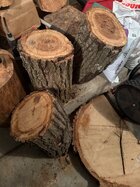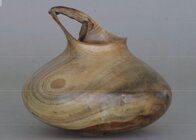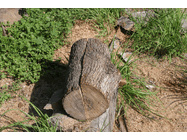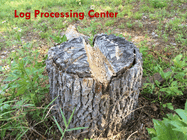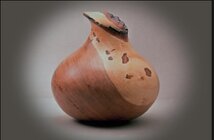One of the videos I watched indicated that, after cutting the log into sections of the size you want, you should find the part of the log where the pith is equidistant from 2 sides of the log and saw it down through that line.
I’ve been doing this for over 20 years. I use the chainsaw if needed but primarily use the shop bandsaw with a sharp 1/2” 3tpi blade. I might resharpen several times before changing blades. With large logs and log sections I do the initial sectioning on my Woodmizer sawmill behind the barn.
If practical, I like to make my 1st cut down the pith. I did some that way today on the shop bandsaw. I located the pith on each end, put a mark and a circle around it to make it easy to see, then rolled the log until I found a stable side if one exists. (If not, I might make a flat spot with the chain saw.) May be able to get more out of the log if the pith is approximately parallel to one side of the log. If wanting to maximize the block, it’s also important to note any limbs splits, and other potential defects and plan around them. If there are any major splits on the end I might adjust things to make the first cut down the largest split. I’m not concerned with drying “checks” since they usually are shallow.
Then, with the log sitting on the stable side, I use a square against the table to draw a vertical line through the pith. Repeat for the other side. Mark the line position on both ends where it can be seen from the top and draw a straight line from end to end to follow with the bandsaw. (Richard Raffan said he doesn’t bother with the straight cutting line, just eyeballs the cut.)
Cut down the line to rip the log into two parts. What I do next depends on the diameter of the log, the amount of good wood on both halves, and the kinds of blanks I can get. Generally, I process for the largest blanks possible since they can but cut down as needed.
I like to make one edge straight enough to sit nicely against the bandsaw fence, then cut a straight line on the other edge. The figure out what sizes of blanks I can get and make further cuts with the new straight edge. If cutting squares for boxes, vases, etc, I will try to make the first cut on each half down the pith - that will leave pith and juvenile wood on the corners of the squares where it will be cut away on the lathe. Same thing with leaving a bit of bark on the opposite corner.
If I have a fairly long log section and the edges and/or pith are skewed in the log half, I might crosscut that half first if shorter sections would allow making larger squares. There are always measurements and decisions to make. I use a square as show in my video to help decide the largest squares I can get from a log half.
If cutting for bowl blanks, I do much the same thing - first lay out the largest rectangle I can make from that half, again, crosscutting a longer log if needed. The goal is to end up with a blank that is rectangular with the length along the grain a little longer than the width. Then make cuts at the ends of that rectangle so that section of the log half can be turned up on it side to keep it well supported to make the tall cut. I may cut more of the ripped surface away if it contains significant juvenile wood or pith since thats where a crack will form first.
Much of this depends on whether I want to turn it green (almost never) or dry first (almost always). Some also depends on the species and the T/R ratio and position of transverse rings in the blank, another likely place to crack in some species. Much of this comes with the experience of making 100s of these.
If the goal is to make a natural edge bowl, I simply cut the sides and cut away pith if needed, then leave the bark side of the log section untouched.
Cutting crotches and burl for bowls or platters is entirely different.
Depending on the wood, the time of year, how long it’s been laying on the ground, and the health of the original tree, all of these cuts might be different depending on what kind of living things I find under the bark or in the middle. Signs of powder post beetles are most concerning since some types can infect other wood in the shop.
(oops, out of time - sorry, didn’t have time to proofread this)
JKJ

